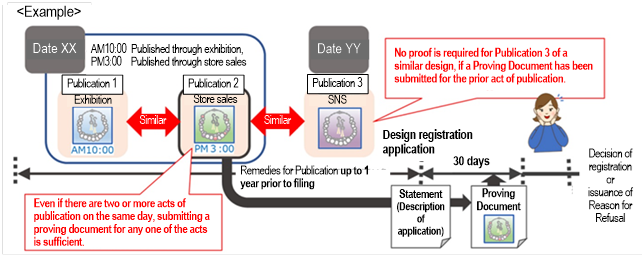2024.10.28
Relaxed Requirements for Procedures to Apply for the Exception to Lack of Novelty in the Design Act
DESIGN
Relaxed Requirements for Procedures to Apply for the Exception to Lack of Novelty in the Design Act
1. Introduction
The Design Act was revised, and the revised Design Act relaxed the procedure to apply for the exception to lack of novelty of design, for applications filed on or after January 1, 2024. As a result of this revision, for designs published through an act of the person entitled to obtain a design registration (or a successor in title), by submitting a proving document for any one of acts of publication on the earliest publication date, the exception to lack of novelty applies not only to the design shown in the proving document but also to any identical or similar designs subsequently published (see the illustration below).
The Design Act was revised, and the revised Design Act relaxed the procedure to apply for the exception to lack of novelty of design, for applications filed on or after January 1, 2024. As a result of this revision, for designs published through an act of the person entitled to obtain a design registration (or a successor in title), by submitting a proving document for any one of acts of publication on the earliest publication date, the exception to lack of novelty applies not only to the design shown in the proving document but also to any identical or similar designs subsequently published (see the illustration below).

2. Background of Relaxation of Procedures to Apply for Exception to Lack of Novelty of Design
(1) Application for Design Registration in Japan
The Design Act stipulates in Article 4 as follows: for a design that lost novelty against the will of the person having the right to obtain a design registration (Article 4, Paragraph 1) or a design that lost novelty as a result of an act of the person having the right to obtain a design registration (Article 4, Paragraph 2), if an application for design registration is filed within one year from the loss of novelty, such a design is exceptionally deemed not to have lost novelty.
The Design Act stipulates, as the procedures for application of Article 4, Paragraph 2, as follows (Article 4, Paragraph 3):
(i) the applicant is required to submit to the Commissioner of the Japan Patent Office, at the time of filing the design registration application, a document stating that the applicant is seeking to apply for the exception to lack of novelty (hereinafter, referred to as a “Statement”); and
(ii) the applicant is also required to submit to the Commissioner of the Japan Patent Office, within 30 days from the filing of the design registration application, a document proving the fact that the design that has otherwise fallen under Article 3, Paragraph 1, Item (i) or (ii) of the Design Act is a design to which Article 4, Paragraph 2 of the Design Act may be applicable (hereinafter, referred to as a “Proving Document”).
Based on the idea that the application of Article 4, Paragraph 2 of the Design Act should be limited to an extent necessary as remedies for creators, only the published design shown in the submitted Statement and Proving Document is excluded from grounds for a reason for refusal in the examination, and such an effect does not cover publication of a design similar to the published design. Thus, in a case where the applicant has published multiple designs similar to the design relevant to the application prior to the filing, the Proving Document should cover not only designs identical to the design relevant to the application but also any other published designs similar to the design relevant to the application, so that they are not deemed as the grounds for a reason for refusal.
Even for identical published designs, Article 4, Paragraph 2 of the Design Act is applied only to publication by the person entitled to obtain the design registration, and is not applied to any publication by others. Thus, for each act of publication, the Proving Document must be submitted for proving that the publication was conducted by the person entitled to obtain the design registration.
However, especially for new users, that is, those who newly file applications for design registration, such as small and medium-sized enterprises and start-up companies, it is an excessive burden to prepare the Proving Document covering all published designs within 30 days from the filing of the design application, which was an obstacle for filing an application.
Therefore, in order to reduce the burden of preparing the Proving Document, Article 4, Paragraph 3 of the Design Act was revised to require the Proving Document only for any one of acts of publication on the earliest publication date among those of identical or similar designs published through the applicant’s own acts.
(2) International Application for Design Registration
In the case of an international design registration application, procedures based on the special provision for the exception to lack of novelty of designs stipulated in Article 60-7 of the Design Act are also permitted. Thus, when the applicant submits the Statement and the Proving Document based on this provision, the applicant is required to submit the Proving Document only for any one of acts of publication on the earliest publication date among those of identical or similar designs published through the applicant’s own acts, similarly to Article 4, Paragraph 3 of the revised Design Act.
3. Advantages of Relaxed Procedures for Applicants
As a result of this revision, applicants have the following advantages:
(1) Once the applicant submits the Proving Document only for the first publication, no Proving Document is required for any subsequent publication;
(2) Whether or not it is the first publication will be determined based on the date, and even if there are multiple publications on the earliest publication date, the applicant is required to submit the Proving Document only for any one of the publications on that date, regardless of the time; and
(3) The effect of submitting the Proving Document covers not only designs identical to the published design but also designs similar to the published design.
(1) Application for Design Registration in Japan
The Design Act stipulates in Article 4 as follows: for a design that lost novelty against the will of the person having the right to obtain a design registration (Article 4, Paragraph 1) or a design that lost novelty as a result of an act of the person having the right to obtain a design registration (Article 4, Paragraph 2), if an application for design registration is filed within one year from the loss of novelty, such a design is exceptionally deemed not to have lost novelty.
The Design Act stipulates, as the procedures for application of Article 4, Paragraph 2, as follows (Article 4, Paragraph 3):
(i) the applicant is required to submit to the Commissioner of the Japan Patent Office, at the time of filing the design registration application, a document stating that the applicant is seeking to apply for the exception to lack of novelty (hereinafter, referred to as a “Statement”); and
(ii) the applicant is also required to submit to the Commissioner of the Japan Patent Office, within 30 days from the filing of the design registration application, a document proving the fact that the design that has otherwise fallen under Article 3, Paragraph 1, Item (i) or (ii) of the Design Act is a design to which Article 4, Paragraph 2 of the Design Act may be applicable (hereinafter, referred to as a “Proving Document”).
Based on the idea that the application of Article 4, Paragraph 2 of the Design Act should be limited to an extent necessary as remedies for creators, only the published design shown in the submitted Statement and Proving Document is excluded from grounds for a reason for refusal in the examination, and such an effect does not cover publication of a design similar to the published design. Thus, in a case where the applicant has published multiple designs similar to the design relevant to the application prior to the filing, the Proving Document should cover not only designs identical to the design relevant to the application but also any other published designs similar to the design relevant to the application, so that they are not deemed as the grounds for a reason for refusal.
Even for identical published designs, Article 4, Paragraph 2 of the Design Act is applied only to publication by the person entitled to obtain the design registration, and is not applied to any publication by others. Thus, for each act of publication, the Proving Document must be submitted for proving that the publication was conducted by the person entitled to obtain the design registration.
However, especially for new users, that is, those who newly file applications for design registration, such as small and medium-sized enterprises and start-up companies, it is an excessive burden to prepare the Proving Document covering all published designs within 30 days from the filing of the design application, which was an obstacle for filing an application.
Therefore, in order to reduce the burden of preparing the Proving Document, Article 4, Paragraph 3 of the Design Act was revised to require the Proving Document only for any one of acts of publication on the earliest publication date among those of identical or similar designs published through the applicant’s own acts.
(2) International Application for Design Registration
In the case of an international design registration application, procedures based on the special provision for the exception to lack of novelty of designs stipulated in Article 60-7 of the Design Act are also permitted. Thus, when the applicant submits the Statement and the Proving Document based on this provision, the applicant is required to submit the Proving Document only for any one of acts of publication on the earliest publication date among those of identical or similar designs published through the applicant’s own acts, similarly to Article 4, Paragraph 3 of the revised Design Act.
3. Advantages of Relaxed Procedures for Applicants
As a result of this revision, applicants have the following advantages:
(1) Once the applicant submits the Proving Document only for the first publication, no Proving Document is required for any subsequent publication;
(2) Whether or not it is the first publication will be determined based on the date, and even if there are multiple publications on the earliest publication date, the applicant is required to submit the Proving Document only for any one of the publications on that date, regardless of the time; and
(3) The effect of submitting the Proving Document covers not only designs identical to the published design but also designs similar to the published design.
End of Article
